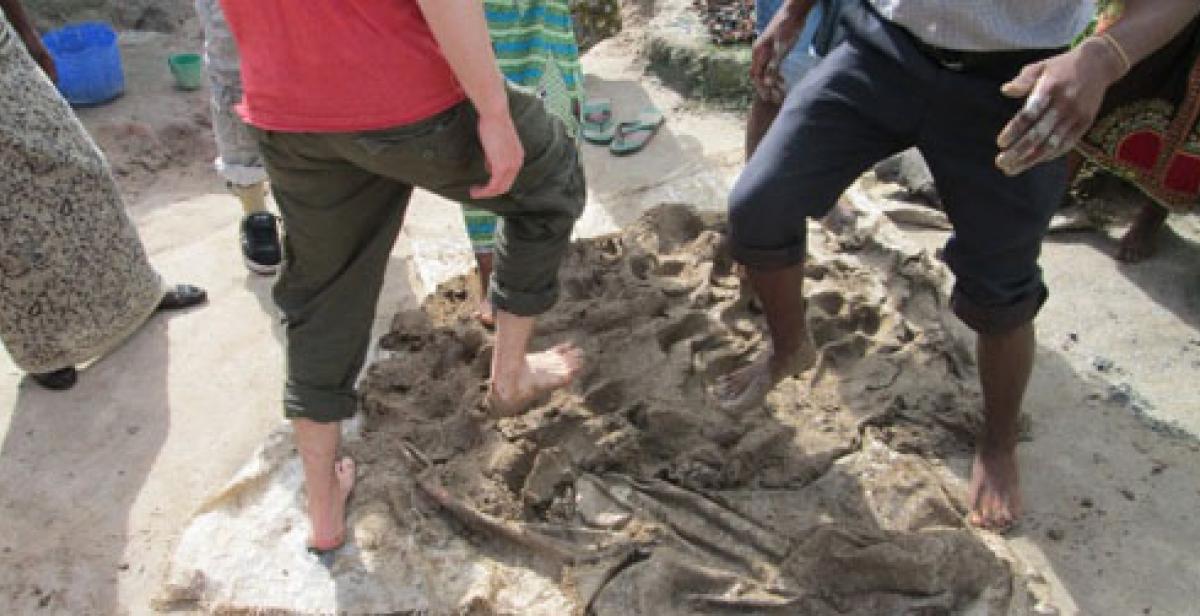How to make a clay cook-stove
Changing the world was never going to be as simple as throwing money at whoever needs it most. To achieve significant, sustainable, and most importantly long-term development, a little creativity is essential.
One of the more surprisingly simple and effective development schemes we came across centred around a very ordinary and unimpressive looking clay pot.
These innocuous little pots have a lot of potential. Allow me to explain…

Figure 1 - Two completed clay cook-stoves
Carbon footprints
If you’ve been alive at any point during the past four or five decades you have probably heard the words ‘Climate change’. If you have been alive and perhaps a little inquisitive you might know that climate change refers to observable shifts in the characteristics of Earth’s atmosphere, most notably an increase in temperature; an infamous phenomenon known as ‘Global Warming’.
In the last couple of hundred years humans have begun inadvertently (and more than a little irresponsibly) to tinker with the delicate layer of gasses that make up our atmosphere by pumping out obscene quantities of greenhouse gasses like C02 and methane. This leads to an increase in adverse weather conditions such as floods, droughts, storms and blizzards. Whichever way you look at it, climate change is bad news for everyone.
So, naturally, the big-wigs want everyone to try to cut down on the amount of greenhouse gasses they produce. Or, to put it another way, reduce their carbon footprint (which is just a fancy way of saying produce less carbon dioxide).
‘Where are you going with this?’ You may wonder. Bear with me a couple of paragraphs more, dear reader, and all will become clear.
Carbon Credits
In order to incentivise carbon-footprint reduction efforts, a non-profit Swiss organisation by the name of Gold Standard came up with an innovative new way of encouraging more environmentally friendly practices on a nationwide scale by making green policies potentially very lucrative for entire countries.
Introducing; Carbon Credits.
Essentially, every country is given a ‘quota’ (or a limit, if you prefer) of how much C02, measured in tonnes, they are allowed to emit in a year.
If a country is over its carbon emission limit for the year, it will incur a fine that increases with every tonne of excess C02. If a country is under the limit, then said country is awarded Carbon Credits. One carbon credit is awarded for every tonne of C02 that is not pumped into the atmosphere.
So, for example, if I am set a limit of 10 tonnes of C02 I can produce that year, and when the year is out I have produced only 5 tonnes of C02, I will be awarded 5 carbon credits; one for every tonne under my limit.
The clever thing is that carbon credits can be sold for real currency between countries as a means of bypassing the fees incurred by going over a C02 limit. This means that if Malawi is half a million tonnes under its C02 emission limit and is subsequently awarded half a million carbon credits, it can sell them to other countries who might have gone over their limit (lookin’ at you, China) thus generating income for the country as a whole.
Put simply, carbon credits are a way of making environmental-friendliness lucrative.
We here at Progressio want to help Malawi to access these carbon credits as a means of income.
That’s where the clay cook-stoves come in.

Figure 2 - A stockpile of completed cook-stoves
Clay Cook-stoves
'Behold, the future!'
Clay cook-stoves are incredibly simple to make; so much so that a handful of soft, inexperienced westerners churned out several perfectly good ones in a couple of hours. They’re a good investment for a number of reasons.
Firstly, they’re much more heat-efficient than an open fire, produce far less smoke and use less wood. Already you’re down on C02and generating carbon-credits.
Secondly, if clay cook-stoves are widely adopted in Malawi then it would go some way to curbing the 12,000 deaths caused each year by respiratory ailments attributed to indoor smoke from open fires.
Thirdly, by producing these stoves in bulk, as shown below, the community we are working to develop can sell the stoves in town, thereby generating income for the community and promoting the widespread use of the stoves.
A crash-course in ceramics
So, how do you actually make one? Just follow these easy steps as modelled by our volunteers.
STEP 1. Prepare the clay.
Lay the clay (good clay is usually found a few feet underground in damp areas) out on a mat and add a sprinkling of water. Then remove your shoes and karate-kick that clay until it’s firm and compact.

Figure 3 - Kicking the clay
The point of this is to compact the clay and make it more malleable. Also, by removing your shoes you can feel for stones which need to be removed to get the best quality possible.
STEP 2. Pack the clay into the mould.
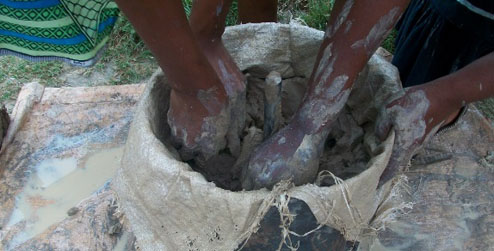
Figure 4 - Packing clay into the mould
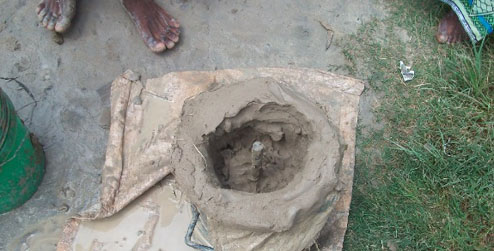
Figure 5 - Clay in mould
The mould in this case is just an iron bucket lined with tarpaulin with a stick going up through the middle. The clay should be stuck to the internal surface of the mould, leaving a space in the middle. This space will become the innards of the final product.
STEP 3. Use the rotary-scraper to shape the inside of the stove.
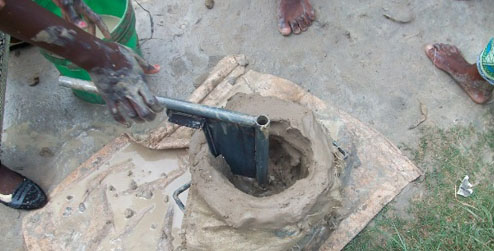
Figure 6 - Using the rotary-scraper
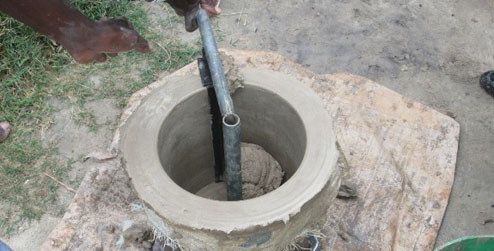
Figure 7 - Shaping the inside of the stove
The wood will go in here.
STEP 5. Appendages! Next, we need to add the 3 supporting legs on which the stove will sit. We can also add the 2 handles at this stage. There is a special measuring disk which shows the correct way to attach these appendages. Simply mark on the clay where each attachment will go.
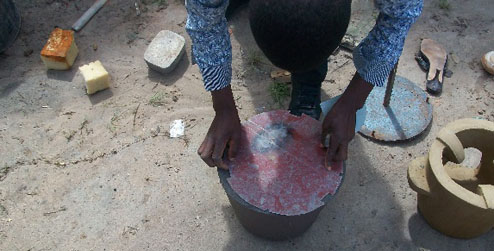
Figure 8 - Marking where each attachment goes
The handles need to be strong, as they will be used to carry the stove. First, make a hole in the appropriate location, then insert a pre-moulded single piece of clay into the hole and smooth out the attachment.

Figure 9 - Making a hole for the handles
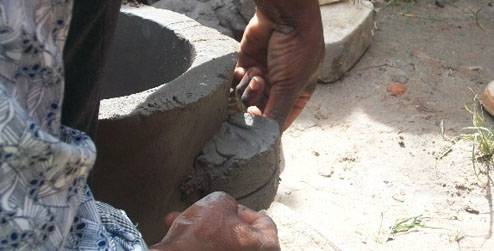
Figure 10 - Adding the handles
Make the three supports using another smaller mould and attach to the rim of the pot at the locations shown by the measuring disk. Score the contact points with a key or sharp stone to ensure that the clay bonds properly.
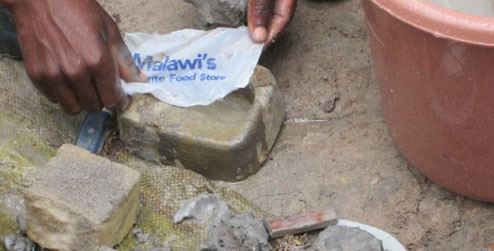
Figure 11 - Making the supports using a mould
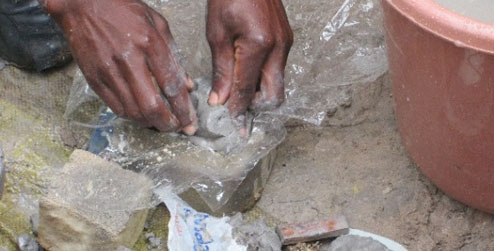
Figure 12 - Making the supports
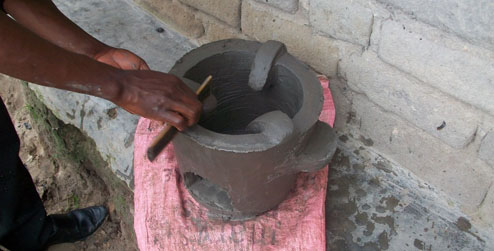
Figure 12 - Finishing touches
And you’re done!
All of this can be achieved using locally sourced materials and is so simple that anyone can learn to do it. If we can get these things to go mainstream, then it could start to generate some serious development.
Sounds great doesn't it? It gets better. If all goes according to plan then we can combine clay cook-stoves with these babies:
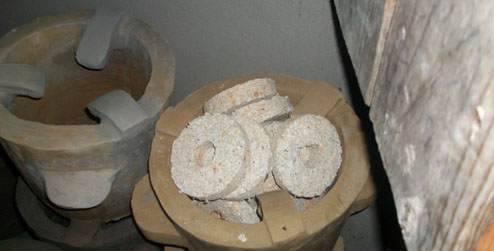
Figure 13 - Briquettes
Those funny donut-like things are briquettes, and while they might not look like much, they are nothing short of brilliant.
Made from waste paper and wood-shavings, briquettes are a more environmentally friendly alternative to firewood. They are more manageable than wood, burn hotter and for longer, produce way less smoke, use up waste paper and curb deforestation by reducing the need for firewood. In short, they are a solution to several of Malawi’s problems at once, while also bringing in boatloads of those precious carbon credits.
So there you have it. clay cook-stoves can not only generate income for small communities when sold as a unit, but also help reduce Malawi's carbon footprint, thereby earning carbon credits and generating income for the country as a whole.
Thomas Inglehearn writes from Malawi


